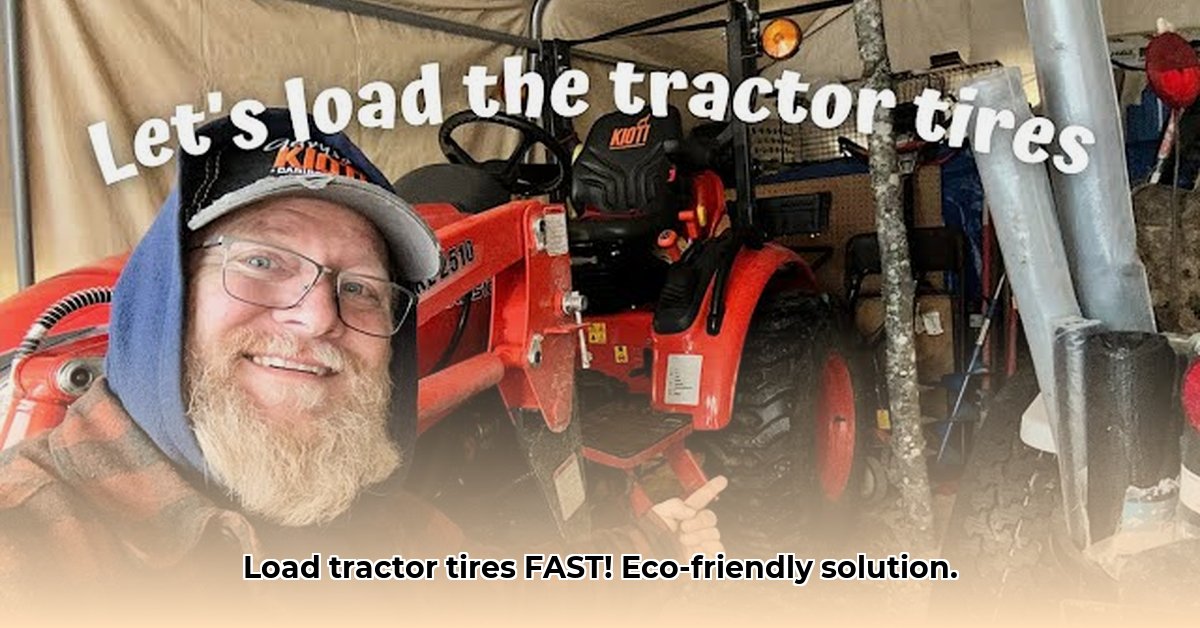
Introducing Windshield Washer Fluid as Tractor Tire Ballast: A Cost-Effective Solution?
Traditional methods of tractor tire ballasting—sand, water, or wheel weights—can be expensive, messy, and time-consuming. This guide explores the feasibility of using windshield washer fluid (WWF) as a ballast alternative, examining its potential cost-effectiveness and ease of implementation while critically evaluating its long-term sustainability and environmental impact. While this method presents intriguing possibilities, it's crucial to weigh the pros and cons before adopting it. For more on tire options, see retread tire options.
Step-by-Step Guide to Ballasting Tractor Tires with Windshield Washer Fluid
Safety Precautions: Always wear safety glasses and gloves. Work in a well-ventilated area. Have assistance available if needed.
Tire Preparation: Remove the tire from the rim (if necessary). Clean the inside of the tire thoroughly. Ensure the valve stem is secure.
Fluid Selection: Choose a high-quality, all-season windshield washer fluid. Before filling the entire tire, test a small amount to ensure it doesn't react negatively with the tire's inner lining. Avoid fluids containing ingredients that might degrade the rubber or cause corrosion.
Filling Process: Use a submersible pump and garden hose for efficient filling. Monitor the process carefully and avoid overfilling. The correct amount will depend on the tire's size and the desired ballast weight.
Pressure Check: After filling, use a calibrated pressure gauge to verify the tire pressure. Consult your tire's specifications for the recommended pressure.
Re-installation: Carefully remount the filled tire onto the wheel and securely tighten the lug nuts.
Leak Check: Inspect the tire for leaks immediately after re-installation. Address any leaks promptly.
Pros and Cons Analysis: A Balanced Perspective
The decision to use WWF for ballasting requires a careful consideration of its advantages and disadvantages.
Pros:
- Cost-Effectiveness: WWF is significantly cheaper than traditional ballasting materials like wheel weights or specialized ballasting fluids. This can lead to substantial cost savings, especially for larger tractors or fleets.
- Ease of Application: The ballasting process is relatively straightforward compared to the labor-intensive methods of filling tires with sand or water.
- Non-corrosive Composition: Many WWF formulations are non-corrosive, reducing the risk of damage to tire components.
Cons:
- Fluid Degradation: WWF may break down over time, reducing its effectiveness as ballast and potentially leading to leaks. The longevity of WWF as a ballast agent remains largely untested.
- Leak Potential: Leaks are a significant concern. Leaking fluid can contaminate the environment and render the ballasting ineffective.
- Disposal Challenges: WWF disposal must comply with local regulations. Improper disposal can have negative environmental consequences.
- Freezing Risk: In colder climates, WWF may freeze, expanding and potentially damaging the tire. Suitable antifreeze additives might help, but their long-term effects on the tire are unknown.
- Lack of Long-Term Data: Extensive research is needed to fully understand the long-term effects of WWF on tire materials and the environment.
Comparison to Traditional Ballasting Methods
The table below compares WWF to other common ballasting methods, considering cost and environmental impact. The data is based on currently available information and may vary depending on specific contexts and regional differences.
| Method | Cost | Environmental Impact | Ease of Use | Long-Term Durability |
|---|---|---|---|---|
| Windshield Washer Fluid | Low | Moderate to High | High | Low |
| Water | Very Low | Low | High | Low |
| Sand | Moderate | Low | Moderate | High |
| Wheel Weights | High | Low | Low | Very High |
Sustainability Considerations and Mitigation Strategies
The lack of long-term research and potential environmental risks are major sustainability concerns. To mitigate these issues:
- Regular Inspections: Perform frequent inspections to detect leaks promptly.
- Leak Prevention Strategies: Consider using thicker inner tubes or implementing sealant solutions to reduce leakage risks.
- Biodegradable Alternatives: Researching and utilizing biodegradable WWF alternatives might significantly improve the environmental profile of this ballasting method.
- Responsible Disposal: Adhere to all local, state, and federal regulations regarding the disposal of used WWF.
Regulatory Compliance: Legal and Practical Aspects
Before using WWF for ballasting, thoroughly research and comply with all applicable local, state, and federal regulations. These regulations likely cover aspects such as hazardous waste disposal, environmental protection, and road safety. Non-compliance can result in significant penalties.
Conclusion: A Balanced Assessment
While the use of windshield washer fluid for tractor tire ballasting offers potential cost advantages and ease of application, significant uncertainties remain. The lack of long-term data on its effects on tires and the environment, along with considerable leakage and disposal challenges, raise significant sustainability concerns. A more thorough scientific investigation is critically needed before this method can be widely recommended as a sustainable alternative to traditional ballasting techniques. Farmers should proceed with caution and prioritize responsible environmental stewardship.
Disclaimer
This guide provides information for educational purposes only. It is not an endorsement of using windshield washer fluid for ballasting tractor tires. The authors and publisher assume no responsibility for any damages or liabilities resulting from the use of this method. Users must comply with all applicable laws and regulations and accept all associated risks.